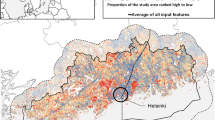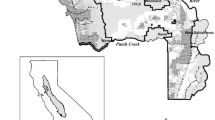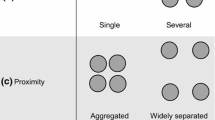Abstract
Ecological patterns and processes operate at a variety of spatial scales. Those which are regional in nature may not be effectively captured through the combination of conservation plans derived at the local level, where land use planning frequently takes place. Conversely, regional conservation plans may not identify resources important for conservation of intraregional ecological variation. We compare modeled conservation networks derived at regional and local scales from the same area in order to analyze the impact of scale effects on conservation planning. Using the MARXAN reserve selection algorithm and least cost corridor analysis we identified a potential regional conservation network for the Central Valley ecoregion of California, USA, from which we extracted those portions found within five individual counties. We then conducted the same analysis for each of the five counties. An overlay of the results from the two scales shows a general pattern of large differences in the identified networks. Especially noteworthy are the trade-offs and omissions evident at both scales of analysis and the disparateness of the identified corridors that connect core reserves. The results suggest that planning efforts limited to one scale will neglect biodiversity patterns and ecological processes that are important at other scales. An intersection of results from the two scales can potentially be used to prioritize areas for conservation found to be important at several spatial scales.




Similar content being viewed by others

References
Andelman SJ, Willig MR (2002) Alternative configurations of conservation reserves for Paraguayan bats: considerations of spatial scale. Conserv Biol 16:1352–1363
Bailey RG (1996) Ecosystem geography. Springer-Verlag, New York
Baker WL (1992) The landscape ecology of large disturbances in the design and management of nature-reserves. Landscape Ecol 7:181–194
Ball IR, Possingham HP (2000) MARXAN (V1.8.2): marine reserve design using spatially explicit annealing, a manual. Available from http://www.uq.edu.au/marxan/docs/marxan_manual_1_8_2.pdf
Beier P, Noss RF (1998) Do habitat corridors provide connectivity? Conserv Biol 12:1241–1252
Beier P, Majka DR, Spencer WD (2008) Forks in the road: choices in procedures for designing wildland linkages. Conserv Biol 22:836–851
Bennett AF (2003) Linkages in the landscape: the role of linkages and connectivity in wildlife conservation. IUCN, Gland
California Resources Agency (2005) Public conservation and trust lands. California Resources Agency, Sacramento
Caro TM, O’Doherty G (1999) On the use of surrogate species in conservation biology. Conserv Biol 13:805–814
CDFG (California Department of Fish and Game—California Interagency Wildlife Task Group) (2005) CWHR version 8.1 personal computer program. California Resources Agency, Sacramento
Cowling RM, Pressey RL, Rouget M, Lombard AT (2003) A conservation plan for a global biodiversity hotspot—the Cape Floristic Region, South Africa. Biol Conserv 112:191–216
Damschen EI, Haddad NM, Orrock JL, Tewksbury JJ, Levey DJ (2006) Corridors increase plant species richness at large scales. Science 313:1284–1286
Davies ZG, Pullin AS (2007) Are hedgerows effective corridors between fragments of woodland habitat? An evidence-based approach. Landscape Ecol 22:333–351
Diamond DD, True CD, Gordon TM, Sowa SP, Foster WE, Jones KB (2005) Influence of targets and assessment region size on perceived conservation priorities. Environ Manag 35:130–137
Erasmus BFN, Freitag S, Gaston KJ, Erasmus BH, van Jaarsveld AS (1999) Scale and conservation planning in the real world. Proc R Soc Bio Sci 266:315–319
ESRI (2005) ArcGIS 9.2. Redlands, CA
FMMP (Farmland Mapping and Monitoring Program) (2004) Important farmland. California Department of Conservation, Sacramento, CA
Forman RTT (1995) Land mosaics: the ecology of landscapes and regions. Cambridge University Press, Cambridge
FRAP (California Department of Forestry and Fire Protection) (2002) Multi-source land cover data. California Department of Forestry and Fire Protection, Sacramento, CA
GIC (Geographical Information Center) (2003) The Central Valley historic mapping project. California State University, Chico
Greco SE, Fremier AK, Larsen EW, Plant RE (2007) A tool for tracking floodplain age land surface patterns on a large meandering river with applications for ecological planning and restoration design. Landscape Urban Plan 81:354–373
Groves CR (2003) Drafting a conservation blueprint: a practitioner’s guide to planning for biodiversity. Island Press, Washington, DC
Groves CR, Jensen DB, Valutis LL, Redford KH, Shaffer ML, Scott JM, Baumgartner JV, Higgins JV, Beck MW, Anderson MG (2002) Planning for biodiversity conservation: putting conservation science into practice. Bioscience 52:499–512
Hickman JC (ed) (1993) The Jepson manual: higher plants of California. University of California Press, Berkeley, CA
Howell JA, Brooks GC, Semenoff-Irving M, Greene C (2002) Population dynamics of tule elk at Point Reyes Seashore, California. J Wildl Manag 66:478–490
Huber PR (2008) The effects of spatial and temporal scale on conservation planning and ecological networks in the Central Valley, California. Dissertation. University of California, Davis
Jacques CN, Jenks JA, Klaver RW (2009) Seasonal movements and home-range use by female pronghorns in sagebrush-steppe communities of western South Dakota. J Mammal 90:433–441
King JR, Anderson CM (2004) Marginal property tax effects of conservation easements: a Vermont case study. Am J Agric Econ 86:919–932
Lambeck RJ (1997) Focal species: a multi-species umbrella for nature conservation. Conserv Biol 11:849–856
Lambeck RJ (2002) Focal species and restoration ecology: response to Lindenmayer et al. Conserv Biol 16:549–551
Lindenmayer DB, Manning AD, Smith PL, Possingham HP, Fischer J, Oliver I, McCarthy MA (2002) The focal-species approach and landscape restoration: a critique. Conserv Biol 16:338–345
Margules CR, Pressey RL (2000) Systematic conservation planning. Nature 405:243–253
Margules CR, Nicholls AO, Pressey RL (1988) Selecting networks of reserves to maximize biological diversity. Biol Conserv 43:63–76
Myers N, Mittermeier RA, Mittermeier CG, da Fonseca GAB, Kent J (2000) Biodiversity hotspots for conservation priorities. Nature 403:853–858
Noss RF, Daly KM (2006) Incorporating connectivity into broad-scale conservation planning. In: Crooks KR, Sanjayan M (eds) Connectivity conservation. Cambridge University Press, Cambridge, pp 587–619
Noss RF, O’Connell MA, Murphy DD (1997) The science of conservation planning. Island Press, Washington, DC
Noss RF, Dinerstein E, Gilbert B, Gilpin M, Miller BJ, Terborgh J, Trombulak S (1999) Core areas: where nature reigns. In: Soulé ME, Terborgh J (eds) Continental conservation: scientific foundations of regional reserve networks. Island Press, Washington, DC, pp 99–128
Olson DM, Dinerstein E, Wikramanyake ED, Burgess ND, Powell GVN, Underwood EC, D’Amico JA, Iitoua I, Strand HE, Morrison JC, Wettengel C, Hedao P, Kassem K (2001) Terrestrial ecoregions of the world: a new map of life on earth. Bioscience 51:933–938
Pascual-Hortal L, Saura S (2007) Impact of spatial scale on the identification of critical habitat patches for the maintenance of landscape connectivity. Landscape Urban Plan 83:176–186
Patten JL, Yang SY (1977) Genetic variation in Thomomys bottae pocket gophers: macrogeographic patterns. Evolution 31:697–720
Poiani KA, Richter BD, Anderson MG, Richter HE (2000) Biodiversity conservation at multiple scales: functional sites, landscapes, and networks. Bioscience 50:133–146
PPIC (Public Policy Institute of California) (2006) California’s Central Valley. Public Policy Institute of California, San Francisco, CA
Prendergast JR, Quinn RM, Lawton JH, Eversham BC, Gibbons DW (1993) Rare species, the coincidence of diversity hotspots and conservation strategies. Nature 365:335–337
Ricketts TH, Dinerstein E, Olson DM (1999) Terrestrial ecoregions of North America: a conservation assessment. Island Press, Washington, DC
Riley SPD, Sauvajot RM, Fuller TK, York EC, Kamradt DA, Bromley C, Wayne RK (2003) Effects of urbanization and habitat fragmentation on bobcats and coyotes in southern California. Conserv Biol 17:566–576
Rosenberg DK, Noon BR, Meslow EC (1997) Biological corridors: form, function, and efficacy. Bioscience 47:677–687
Rothley KD (1999) Designing bioreserve networks to satisfy multiple, conflicting demands. Ecol Appl 9:741–750
Rouget M (2003) Measuring conservation value at fine and broad scales: implications for a diverse and fragmented region, the Agulhas Plain. Biol Conserv 112:217–232
Seo C, Thorne JH, Hannah L, Thuiller W (2009) Scale effects in species distribution models: implications for conservation planning under climate change. Biol Lett 5:39–43
Shriner SA, Wilson KR, Flather CH (2006) Reserve networks based on richness hotspots and representation vary with scale. Ecol Appl 16:1660–1673
Simberloff D, Farr JA, Cox J, Mehlman DW (1992) Movement corridors—conservation bargains or poor investments. Conserv Biol 6:493–504
Simberloff DJ, Doak D, Groom M, Trumbulak S, Dobson A, Gatewood S, Soulé ME, Gilpin M, Martinez del Rio C, Mills L (1999) Regional and continental restoration. In: Soulé ME, Terborgh J (eds) Continental conservation: scientific foundations of regional reserve networks. Island Press, Washington, DC, pp 65–98
Soulé ME, Terborgh J (eds) (1999) Continental conservation: scientific foundations of regional reserve networks. Island Press, Washington, DC
Svancara LK, Brannon R, Scott JM, Groves CR, Noss RF, Pressey RL (2005) Policy-driven versus evidence-based conservation: a review of political targets and biological needs. Bioscience 55:989–995
Tewksbury JJ, Levey DJ, Haddad NM, Sargent S, Orrock JL, Weldon A, Danielson BJ, Brinkerhoff J, Damschen EI, Townsend P (2002) Corridors affect plants, animals, and their interactions in fragmented landscapes. Proc Natl Acad Sci USA 99:12923–12926
Theobald DM (2006) Exploring the functional connectivity of landscapes using landscape networks. In: Crooks KR, Sanjayan M (eds) Connectivity conservation. Cambridge University Press, Cambridge, pp 416–443
Theobald DM, Spies T, Kline J, Maxwell B, Hobbs NT, Dale VH (2005) Ecological support for rural land-use planning. Ecol Appl 15:1906–1914
Thorne JH, Cameron D, Quinn JF (2006) A conservation design for the Central Coast of California and the evaluation of mountain lion as an umbrella species. Nat Area J 26:137–148
Thorne JT, Huber PR, Girvetz EH, Quinn J, McCoy MC (2009) Integration of regional mitigation assessment and conservation planning. Ecol Soc 14:47
Turner AM, Trexler JC, Jordan CF, Slack SJ, Geddes P, Chick JH, Loftus WF (1999) Targeting ecosystem features for conservation: standing crops in the Florida Everglades. Conserv Biol 13:898–911
U.S. Department of Commerce (2007) TIGER/Line Shapefile, 2007, California Local Roads. U.S. Department of Commerce, Washington, DC
USFWS (U.S. Fish and Wildlife Service) (1998) Central Valley vernal pool complexes (Holland). U.S. Fish and Wildlife Service, Sacramento, CA
USGS (U.S. Geological Survey) (1999) National hydrography dataset. U.S. Department of the Interior, Washington, DC
Vazquez LB, Rodriguez P, Arita HT (2008) Conservation planning in a subdivided world. Biodivers Conserv 17:1367–1377
Warman LD, Sinclair ARE, Scudder GGE, Klinkenberg B, Pressey RL (2004) Sensitivity of systematic reserve selection to decisions about scale, biological data, and targets: case study from southern British Columbia. Conserv Biol 18:655–666
Wiens JA, Hayward GD, Holthausen RS, Wisdom MJ (2008) Using surrogate species and groups for conservation planning and management. Bioscience 58:241–252
Wiersma YF (2007) The effect of target extent on the location of optimal protected areas networks in Canada. Landscape Ecol 22:1477–1487
Acknowledgments
The authors would like to thank the Arenz Foundation for their support of this project. We would also like to thank Rob Thayer for his helpful comments on earlier versions of this manuscript.
Author information
Authors and Affiliations
Corresponding author
Rights and permissions
About this article
Cite this article
Huber, P.R., Greco, S.E. & Thorne, J.H. Spatial scale effects on conservation network design: trade-offs and omissions in regional versus local scale planning. Landscape Ecol 25, 683–695 (2010). https://doi.org/10.1007/s10980-010-9447-4
Received:
Accepted:
Published:
Issue Date:
DOI: https://doi.org/10.1007/s10980-010-9447-4



